| Psilopogon | |
|---|---|
 | |
| Fire-tufted barbet (Psilopogon pyrolophus) | |
| Scientific classification | |
| Domain: | Eukaryota |
| Kingdom: | Animalia |
| Phylum: | Chordata |
| Class: | Aves |
| Order: | Piciformes |
| Family: | Megalaimidae |
| Genus: | Psilopogon Müller, S., 1836 |
| Type species | |
| Psilopogon pyrolophus Müller, S. | |
| Synonyms | |
|
Megalaima G. R. Gray, 1842 | |
Psilopogon is a genus of Old World barbets that used to include only a single species, the fire-tufted barbet (P. pyrolophus). Results of molecular phylogenetic analyses indicate that the genus is nested within an evolutionary branch consisting of Asian barbets that were formerly placed in the genus Megalaima proposed by George Robert Gray in 1841. Since Psilopogon was proposed by Salomon Müller already in 1835, this name takes priority.[1][2]
The name Psilopogon combines the Ancient Greek psilos meaning "bare" and pōgōn meaning "beard".[3]
Taxonomy
The genus Psilopogon was introduced in 1836 by the German naturalist Salomon Müller to accommodate a single species, the fire-tufted barbet (Psilopogon pyrolophus), which is therefore the type species.[4][5]
In the 19th and 20th centuries, about 19 generic names were proposed for Asian barbet species in collections of natural history museums, including Megalaima by George Robert Gray in 1849 and Mezobucco by George Ernest Shelley in 1889.[6] Molecular phylogenetic research of Asian barbets revealed that the Megalaima species form a clade, which also includes the fire-tufted barbet. Barbets formerly placed in Megalaima were therefore reclassified under the genus Psilopogon, which now contains the following 33 species:[7]
As of February 2023, the list of birds maintained by Frank Gill, Pamela Rasmussen and David Donsker on behalf of the International Ornithological Committee (IOC) as well as the Clements Checklist of Birds of the World maintained by members of Cornell University both treat Psilopogon cyanotis as a subspecies of Psilopogon duvaucellii.[8][9] The taxon Psilopogon cyanotis was not included in the 2013 molecular phylogenetic study by Robert Jan den Tex and Jennifer Leonard.[1]
| Species | Image | Distribution |
|---|---|---|
| Fire-tufted barbet (P. pyrolophus) |  |
Peninsular Malaysia and Sumatra |
| Coppersmith barbet (P. haemacephalus) (Statius Müller, 1776)[10] | _in_Kolkata_I_IMG_7583.jpg.webp) |
from Pakistan to the Philippines and Indonesia |
| White-cheeked barbet (P. viridis) (Boddaert, 1783)[11] | _4.jpg.webp) |
Western Ghats and adjoining hills |
| Great barbet (P. virens) (Boddaert, 1783)[12] |  |
northern India, Nepal and Bhutan, Bangladesh and some parts of Southeast Asia, as far east as Laos |
| Brown-headed barbet (P. zeylanicus) (Gmelin, 1788) |  |
Western Ghats and hilly parts of southern peninsular India |
| Crimson-fronted barbet (P. rubricapillus) Gmelin, 1788) | .jpg.webp) |
Sri Lanka |
| Blue-throated barbet (P. asiaticus) (Latham, 1790) | _on_Kapok_(Ceiba_pentandra)_in_Kolkata_W_IMG_4293.jpg.webp) |
Indian subcontinent and Southeast Asia |
| Lineated barbet (P. lineatus) (Vieillot, 1816) | .JPG.webp) |
West Bengal and Bangladesh |
| Yellow-fronted barbet (P. flavifrons) (Cuvier, 1816) | 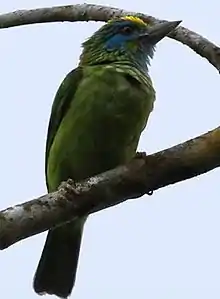 |
Sri Lanka |
| Black-banded barbet (P. javensis) (Horsfield, 1821) | 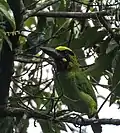 |
Java and Bali |
| Yellow-eared barbet (P. australis) (Horsfield, 1821) | .jpg.webp) |
Java and Bali |
| Flame-fronted barbet (P. armillaris) (Temminck, 1821) | .jpg.webp) |
Java and Bali |
| Golden-whiskered barbet (P. chrysopogon) (Temminck, 1824) | 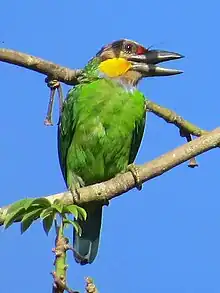 |
Brunei, Indonesia, Malaysia, Thailand, Borneo and Sumatra |
| Red-throated barbet (P. mystacophanos) (Temminck, 1824) | .jpg.webp) |
Myanmar, Thailand, Malaysia, Singapore, Indonesia, Brunei |
| Black-eared barbet (P. duvaucelii) (Lesson, 1830) | .jpg.webp) |
Peninsular Malaysia, Sumatra and Borneo |
| Green-eared barbet (P. faiostrictus) (Temminck, 1831) |  |
southern China, Cambodia, Laos, Thailand and Vietnam |
| Brown-throated barbet (P. corvinus) (Temminck, 1831) |  |
western Java |
| Yellow-crowned barbet (P. henricii) (Temminck, 1831) | 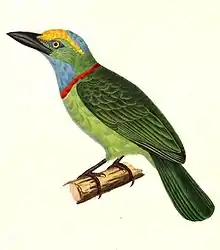 |
Brunei, Indonesia, Malaysia, Singapore, and Thailand |
| Black-browed barbet (P. oorti) (Müller, 1836) | .jpg.webp) |
Sumatra and the Malay Peninsula |
| Red-crowned barbet (P. rafflesii) (Lesson, 1839) | .jpg.webp) |
Brunei, Indonesia, Malaysia, Myanmar, Singapore, and Thailand |
| Golden-throated barbet (P. franklinii) (Edward Blyth, 1842)[13] | .jpg.webp) |
Nepal, India, Bhutan, Myanmar, Thailand, Malaysia, Laos, Vietnam and mainland China |
| Blue-eared barbet (P. cyanotis) (Blyth, 1847) | .jpg.webp) |
northeast India and Bangladesh to peninsular Thailand |
| Malabar barbet (P. malabaricus) (Blyth, 1847) | _-_Male_-_Sakleshpur_-_India_-2009.jpg.webp) |
Western Ghats from around Goa south to southern Kerala |
| Taiwan barbet (P. nuchalis) (Gould, 1863) |  |
Taiwan |
| Red-vented barbet (P. lagrandieri) (Verreaux, 1868) |  |
Cambodia, Laos and Vietnam |
| Chinese barbet (P. faber) (R. Swinhoe, 1870) | 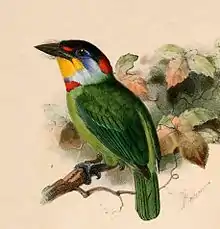 |
southern China |
| Moustached barbet (P. incognitus) (Hume, 1874) | .jpg.webp) |
Myanmar, Thailand, Cambodia, Laos and Vietnam |
| Golden-naped barbet (P. pulcherrimus) (Sharpe, 1888) | 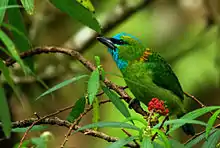 |
Indonesia and Malaysia |
| Mountain barbet (P. monticola) (Sharpe, 1889) | Borneo | |
| Bornean barbet (P. eximius) (Sharpe, 1892) |  |
Indonesia and Malaysia, Borneo |
| Necklaced barbet (P. auricularis) (Robinson & Kloss, 1919) | southern Laos and Vietnam | |
| Indochinese barbet (P. annamensis) (Robinson & Kloss, 1919) | Laos, Vietnam and Cambodia | |
| Turquoise-throated barbet (P. chersonesus) (Chasen & Kloss, 1927) | .jpg.webp) |
Thailand |
Phylogeny
| ||||||||||||||||||||||||||||||||||||||||||||||||||||||||||||||||||||||||||||||||||||||||||||||||||||||||||||||||||||||||||||||||||||||||||||||||||||||||||||||||||||||||||||||||||||||||||||||||||||||
| Relationship within the genus[1] |
References
- 1 2 3 Den Tex, R.-J.; Leonard, J. A. (2013). "A molecular phylogeny of Asian barbets: Speciation and extinction in the tropics". Molecular Phylogenetics and Evolution. 68 (1): 1–13. doi:10.1016/j.ympev.2013.03.004. PMID 23511217.
- ↑ Ericson, P. G. P. (2012). "Evolution of terrestrial birds in three continents: biogeography and parallel radiations". Journal of Biogeography. 39 (5): 813–824. doi:10.1111/j.1365-2699.2011.02650.x. S2CID 85599747.
- ↑ Jobling, James A. (2010). The Helm Dictionary of Scientific Bird Names. London: Christopher Helm. p. 321. ISBN 978-1-4081-2501-4.
- ↑ Müller, Salomon (1835). "Aanteekeningen over de natuurlijke gesteldheid van een gedeelte der westkust en binnenlanden van Sumatra, met bijvoeging van eenige waarnemingen en beschrijvingen van verscheid dieren". Tijdschrift voor Natuurlijke Geschiedenis en Physiologie (in Dutch). 2: 315–355 [339]. The title page is dated 1835 but the article was not published until 1836.
- ↑ Peters, James Lee, ed. (1948). Check-list of Birds of the World. Vol. 6. Cambridge, Massachusetts: Harvard University Press. p. 30.
- ↑ Ripley, S. D. (1945). "The barbets" (PDF). The Auk. 62 (4): 542–563. doi:10.2307/4079804. JSTOR 4079804.
- ↑ Moyle, R. G. (2004). "Phylogenetics of barbets (Aves: Piciformes) based on nuclear and mitochondrial DNA sequence data". Molecular Phylogenetics and Evolution. 30 (1): 187–200. doi:10.1016/S1055-7903(03)00179-9. PMID 15022769.
- ↑ Gill, Frank; Donsker, David; Rasmussen, Pamela, eds. (January 2023). "Jacamars, puffbirds, toucans, barbets, honeyguides". IOC World Bird List Version 13.1. International Ornithologists' Union. Retrieved 17 February 2023.
- ↑ Clements, J.F.; Schulenberg, T.S.; Iliff, M.J.; Fredericks, T.A.; Gerbracht, J.A.; Lepage, D.; Billerman, S.M.; Sullivan, B.L.; Wood, C.L. (2022). "The eBird/Clements Checklist of Birds of the World: v2022". Retrieved 10 December 2022.
- ↑ Statius Müller, P. L. (1776). "Der Blutskopf. Bucco haemacephalus". Des Ritters Carl von Linné Königlich Schwedischen Leibarztes &c. &c. vollständigen Natursystems. Supplements- und Register-Band über alle sechs Theile oder Classen des Thierreichs. Nürnberg: Gabriel Nicolaus Raspe. p. 88.
- ↑ Boddaert, P. (1783). "870. Barbu verd, Buff. XIII". Table des Planches Enluminées d'histoire naturelle de M. D'Aubenton : avec les denominations de M.M. de Buffon, Brisson, Edwards, Linnaeus et Latham, precedé d'une notice des principaux ouvrages zoologiques enluminés. Utrecht. p. 53.
- ↑ Boddaert, P. (1783). "871. Le grand Barbu, Buff. XIII". Table des Planches Enluminées d'histoire naturelle de M. D'Aubenton : avec les denominations de M.M. de Buffon, Brisson, Edwards, Linnaeus et Latham, precedé d'une notice des principaux ouvrages zoologiques enluminés. Utrecht. p. 53.
- ↑ Blyth, E. (1842). "Notes on various Indian and Malayan birds". The Journal of the Asiatic Society of Bengal. 11 (1): 160–195.